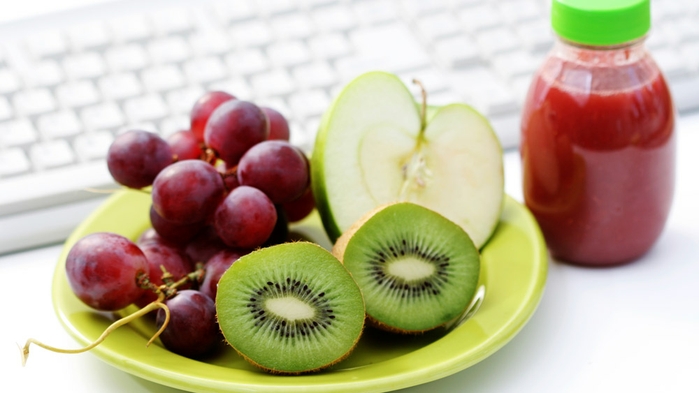It’s 3 o’clock and you’re running low on energy. Like most people, your natural reaction is to grab a soda or a snack for a boost that can carry you through the end of the workday.
But experts say that buying whatever is stocked in the office vending machine can undermine your health and diet.
“People hit a wall if they haven’t eaten a balanced meal at breakfast and lunch,” said Michelle Ray, a nutrition specialist at Novant Health Heart and Vascular Institute in Charlotte, North Carolina. “Many of the people I see skipped either breakfast or lunch or they didn’t get a good source of protein at lunch and are now hungry.”
“I tell my clients that while an apple is a good snack, it’s not balanced enough to keep someone sated,” Ray added. “But in combination with a piece of whole-grain bread with peanut butter, the apple can keep someone energized.”
People snack at work a great deal, which really is not surprising given that most of us spend the most of our waking hours at the office. A nutrition study found Americans are snacking more frequently now than they did 20 years ago and are taking in about 24 percent of their calories from snacks.
Snacking is not necessarily a bad thing. In fact, Ray says it’s critical. “People should eat their first meal within two hours of waking and should go no longer than four hours without food,” Ray said. “If they get up at 6 a.m., eat breakfast and are having lunch at noon, they need a midmorning snack.”
The same nutrition study showed that over the same period, the types of snacks we’re eating has also changed. Today, we consume more salty snacks, chips and nuts and fewer fruits and dairy products.
What you eat is as important as how much you eat. Another study by the American Heart Association found that eating snacks high in trans fat, a type of fat that is common in cakes, cookies and potato chips – all items often found in vending machines – was linked to memory loss. Among the 698 working age men tested in the study, those who ate the most snacks with trans fat did not perform as well on memory tests than their peers who consumed less of this type of fat.
No wonder we have to be careful about what we eat at work, especially when it comes to mindless eating. It is pretty easy to grab a handful of chocolate when you pass your colleague’s candy jar or a few cookies someone put out in the break room, but all those little indulgences add up.
About one-third of the calories Americans consume a day are in the form of empty calories from snacking, according to a survey by the U.S. Department of Agriculture. So if you’re going to succumb to temptation, try to make those calories count and chose nutritious and healthy foods.
Ray recommended keeping snacks balanced. “They should always include whole grains, a source of protein and a piece of fruit or vegetable. Whole-grain crackers with hummus are a great choice.”
Plus, you won’t fall victim to temptations if you have planned out snacks. “If you get into healthy habits, cravings for sugary snacks will be diminished over time,” Ray said.
Other advice:
- Take a break. Eating at your desk, particularly if it’s your lunch as you shuffle papers or do research on the Web, is not good. Take the time to enjoy whatever you’re eating. “Be more present in your eating,” Ray said. “Eat your meal without a distraction.”
- Grab a snack when you’re hungry – not because you’re stressed, bored or frustrated.
- Plan your own snack drawer and stock it up with good things so you won’t be tempted by the candy bar down the hall.
Here are some snack ideas Ray recommends to her clients:
- 1/2 apple with 2 tsp. of peanut butter
- 1 orange with 4-6 dry-roasted nuts
- 1 cup melon with 1/4 cup low-fat cottage cheese
- 1/2 small avocado
- 2 ounces lean roast beef
- PB&J sandwich made with whole-grain bread and low-sugar jelly
- Celery sticks with light cream cheese
- Hard-boiled egg with whole-grain bread
- String cheese
- Low-fat yogurt with fresh fruit
- Raw veggies with hummus
- Whole grain crackers with tuna salad made with light mayo
- 1/4 cup trail mix
Drinks can be a huge source of sugar so choose them wisely. A Snapple iced tea with lemon has 100 calories while a plain Lipton tea brewed at work has no calories. A 12-ounce can of Coke has 140 calories while a glass of water has none. And remember the 8 x 8 rule to stay hydrated: drink eight 8-ounce glasses of water a day.
If you don’t care for plain water, try lemon-infused water or flavored sparkling water.
Ray doesn’t recommend fruit juices and says eating the orange rather than drinking the orange juice is more beneficial because of the fiber in the fruit. “Juice drinks are really just Kool-Aid,” she said. “If you look at the labels, there is very little juice in them.” They also pack a lot of sugar, she added.
All told, snacking doesn’t have to be bad for your health. When you make conscious decisions to choose healthier options, snacks become a welcome supplement to a balanced diet.




